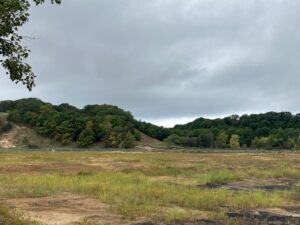By Tanya Cabala, Lakeshore Outreach Organizer for WMEAC
This blog was originally published in the Grand Haven Tribune as part of WMEAC’s monthly opinion piece series. We are pleased to share it with our readers in this new format.
After more than a century of industrial use, Harbor Island is poised for a transformation. Once home to a city dump and coal-fired power plant, the island is now at the center of a vision for Grand Haven’s cleaner, greener future. With the coal pile on the island set for removal later this fall or during the winter of 2025, and environmental investigation and cleanup ongoing, this is a turning point. What happens next depends on the community.
A Brief History of Harbor Island
Harbor Island’s history stretches back centuries. Indigenous peoples like the Ojibwe, Odawa, and Potawatomi lived in the region by the 1600s, using the rivers for transportation and trade. By the 20th century, industrialization had turned the island into a city dump and later the site of the JB Simms coal plant, which operated from the early 1960s until its closure in 2020.
Even though the coal plant is gone, environmental challenges linger in the form of coal ash and PFAS contamination.
What Are Coal Ash and PFAS?
Coal ash is the waste left from burning coal, and it contains toxic substances that can pollute water and soil. PFAS, also known as “forever chemicals,” are industrial pollutants that don’t easily break down and pose serious risks to human health and the environment.
Why Cleanup is Needed
Coal ash contains hazardous heavy metals like arsenic, lead, and mercury that can leach into groundwater, threatening drinking water and ecosystems. PFAS (and PFOA and PFOS) chemicals, found during testing on the island in 2022, pose additional risks. These chemicals are linked to health issues like liver damage, developmental problems in children, and certain cancers.
The city hired HDR to lead the investigation and cleanup efforts, with public input playing a key role in the island’s potential redevelopment. HDR specializes in architecture, engineering, environmental, and construction services. For more information, visit their About Us page.
What’s Next for Harbor Island?
Three main visions for Harbor Island’s future were put forward by HDR, and through community visioning meetings and a survey, two have emerged as top choices, each offering different opportunities for the community:
Green Space & Public Park
Imagine walking trails, restored wetlands, and areas for recreation. This option would enhance biodiversity, improve air and water quality, and provide space for community activities. Creating a green space and public park would significantly benefit the community’s well-being. Additionally, public use could encourage local tourism and economic activity through outdoor events and recreational programs. While ongoing maintenance and funding will be important considerations, these factors can certainly be addressed in the final plans, reflecting the community’s priorities and values.
Eco-Industrial Hub
This concept envisions renewable energy projects and sustainability-oriented businesses, potentially making Grand Haven a leader in green industries. An eco-industrial hub could promote renewable energy initiatives and foster sustainability-oriented businesses, creating green jobs and reducing environmental impacts through localized practices. Engaging the local economy through partnerships with existing businesses and offering incentives for green startups could enhance community investment. Importantly, any potential environmental impacts can be properly addressed in the final plans, ensuring that community feedback shapes the project in a balanced way.
Inspiring Examples of Transformation
There are examples in Michigan of transforming industrial sites into vibrant green spaces or sustainable developments, such as:
- Milliken State Park in Detroit: Once an industrial shipping site, this area on the Detroit River has been converted into Michigan’s first urban state park, featuring wetlands, trails, and wildlife habitats—a peaceful retreat in the heart of the city.
- Chevy Commons in Flint: Formerly a General Motors manufacturing site, this area was heavily contaminated. Now, after cleanup and restoration efforts, it’s being redeveloped into a public park with trails, native plantings, and community spaces, contributing to the city’s resurgence.
- Muskegon Innovation Hub (formerly the Michigan Alternative and Renewable Energy Center – MAREC): Located on the site of a former industrial foundry, this project turned a brownfield into an eco-industrial park focusing on renewable energy production. The site houses solar energy facilities and supports green businesses, demonstrating how former industrial lands can be repurposed to support sustainability and local economic growth.
These examples show how communities across Michigan are reclaiming their industrial past and creating healthier environments. Harbor Island could be next, with the Grand Haven area community guiding its future.
How You Can Help
The removal of the coal pile will be a major milestone, but the transformation of Harbor Island is just beginning. The community’s input will shape its future—whether it becomes a public park or an eco-industrial hub. Stay engaged by visiting the Renew Harbor Island website (renewharborisland.org) for updates and opportunities to share your feedback.
Photo Credit: Lynn Moore


